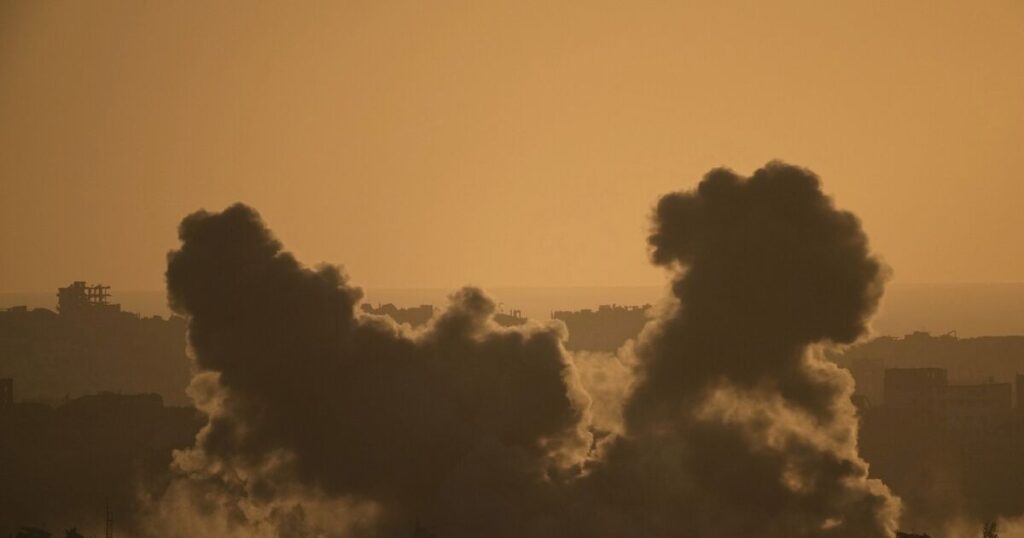At least 40 Palestinians have been killed in Israeli airstrikes in the Gaza Strip, hospital officials said on Wednesday, as international mediators raced to complete a ceasefire deal.
Israeli prime minister Benjamin Netanyahu had a second meeting in two days with US president Donald Trump at the White House on Tuesday evening.
Mr. Trump has been pushing for a ceasefire that might lead to an end to the 21-month war in Gaza. Israel and Hamas are considering a new US-backed ceasefire proposal that would pause the war, free Israeli hostages, and send much-needed aid into Gaza.
Nasser Hospital in the southern city of Khan Younis said the dead included 17 women and 10 children. It said one strike killed 10 people from the same family, including three children.
The Israeli military did not comment on specific strikes, but said it had struck more than 100 targets across Gaza over the past day, including militants, booby-trapped structures, weapons storage facilities, missile launchers, and tunnels. Israel accuses Hamas of hiding weapons and fighters among civilians.
Many Palestinians are watching the ceasefire negotiations with trepidation, desperate for an end to the war.
In the sprawling coastal Muwasi area, where many live in ad-hoc tents after being displaced from their homes, Abeer al-Najjar said she had struggled during the constant bombardments to secure sufficient food and water for her family.
“I pray to God that there would be a pause, and not just a pause where they would lie to us with a month or two, then start doing what they’re doing to us again. We want a full ceasefire,” she said.
Her husband, Ali al-Najjar, said life had been especially tough in the summer, with no access to drinking water in a crowded tent in the heat of the Middle East.
“We hope this would be the end of our suffering and we can rebuild our country again,” he said, before running through a crowd with two buckets to fill them from a water truck.
People chased the vehicle as it drove away to another location.
Amani Abu-Omar said the water truck came every four days, not enough for her dehydrated children. She complained of skin rashes in the summer heat. She said she was desperate for a ceasefire but feared she would be let down again.
“We had expected ceasefires on many occasions, but it was for nothing,” she said.
The war started after Hamas attacked Israel on October 7, 2023, killing around 1,200 people and taking 251 hostage. Most of the hostages have been released in earlier ceasefires. Israel’s offensive in Gaza has killed more than 57,000 Palestinians, more than half of them women and children, according to Gaza’s health ministry.
The ministry, which is under Gaza’s Hamas-run government, does not differentiate between civilians and combatants. The UN and other international organisations see its figures as the most reliable statistics on war casualties.
Mr. Netanyahu told reporters in the Capitol on Tuesday that he and Mr. Trump saw “eye to eye” on the need to destroy Hamas. He added that the co-operation and co-ordination between Israel and the US was currently the best it had ever been during Israel’s 77-year-history.
Later this week, Mr. Trump’s Middle East envoy, Steve Witkoff, is expected to head to the Qatari capital of Doha to continue indirect negotiations with Hamas on the ceasefire proposal.
Mr. Witkoff said late on Tuesday that three key areas of disagreement had been resolved, but that one key issue still remained. He did not elaborate.
After the second meeting, Mr. Netanyahu said he and Mr. Trump also discussed the “great victory” over Iran from Israeli and American strikes during the 12-day war that ended two weeks ago.
“Opportunities have been opened here for expanding the circle of peace, for expanding the Abraham Accords,” Mr. Netanyahu said, referring to normalisation agreements between Israel and multiple Arab nations that were brokered by Mr. Trump in his first term.
Washington has been pushing for normalisation between Saudi Arabia and Israel.


